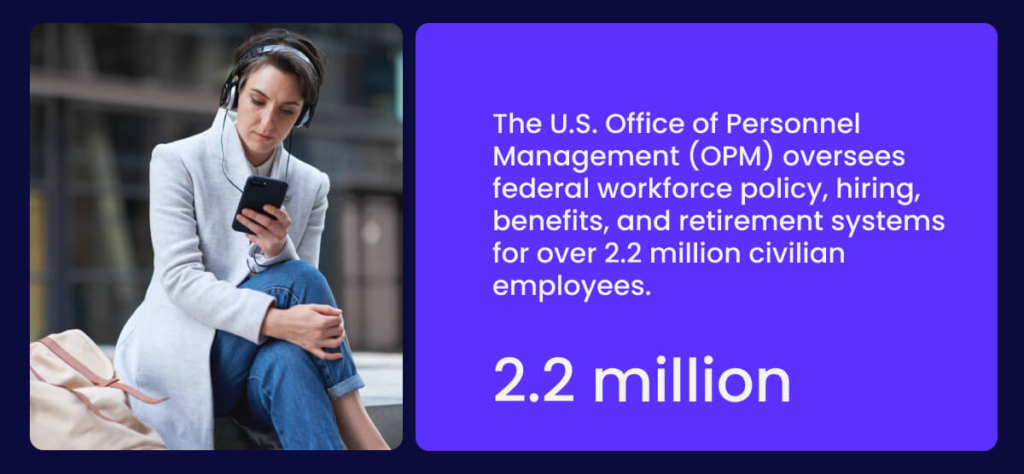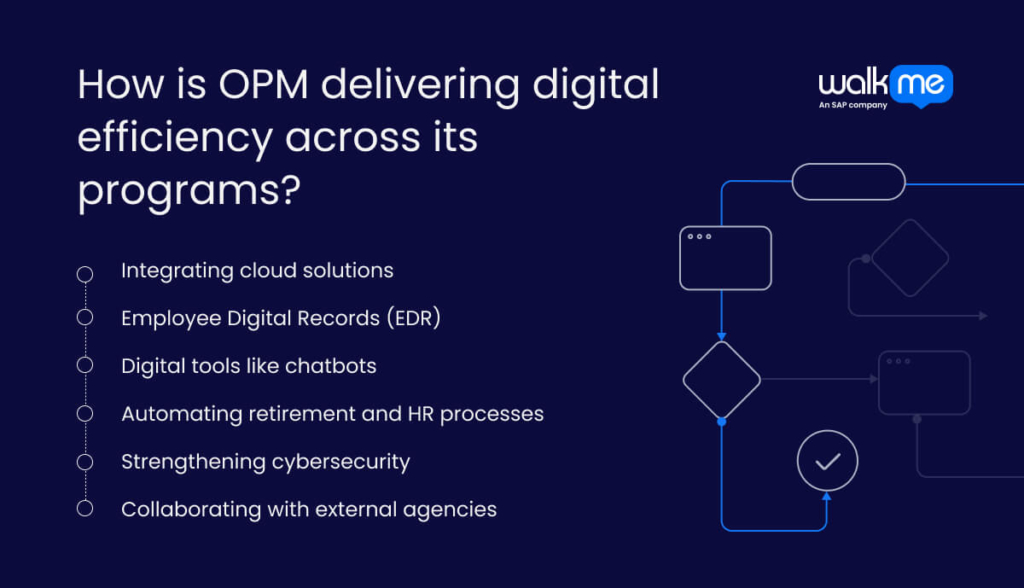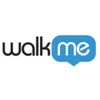The U.S. Office of Personnel Management (OPM) oversees federal workforce policy, hiring, benefits, and retirement systems for over 2.2 million civilian employees.

A cornerstone of government functionality, the OPM has accelerated its digital efficiency efforts by modernizing HR legacy applications, automating pension processing, and integrating secure cloud ecosystems.
According to OPM’s 2024 Annual Performance Report, the agency reduced the average processing time for new retirement cases by more than 20% compared to FY 2023. This led to a 13% rise in customer satisfaction, which in turn prompted the Inspector General to remove the backlog from the list of top management challenges.
OPM’s digital gains signal a wider federal strategy to modernize workforce systems and restore public confidence through measurable performance improvements.
This article examines how the Office of Personnel Management is embedding digital efficiency across retirement, HR, and performance systems to build a faster, fairer, and more resilient federal workforce.
What is digital efficiency at the Office of Personnel Management?
Digital efficiency at the Office of Personnel Management (OPM) involves utilizing smart, connected technology to mitigate delays, minimize errors, and enhance federal HR services.
This includes automating background checks, expediting security clearance transfers, and synchronizing personnel records between agencies through secure data-sharing tools.
One major example is the e‑OPF system, which converted over 32 million paper personnel files into digital records. What once took weeks to retrieve, sort, and collect now takes a matter of minutes.
This efficiency change enabled executive agencies to onboard staff more quickly, eliminate repetitive paperwork, and maintain up-to-date employee records. In the long run, OPM’s goal is a faster, safer, and more connected federal workforce system.
Why is digital efficiency important at the Office of Personnel Management?
Digital efficiency is essential at OPM because delays in HR processing directly affect how quickly agencies can hire, pay, or retire employees.
For example, before digitization, security clearance transfers between agencies could take months, slowing critical appointments. Now, the OPM uses e‑QIP, an online system that automates parts of the security clearance process.
Before e‑QIP, clearance forms were paper-based, error-prone, and frequently rejected. With digital submission, rejection rates dropped by 15%, and processing times improved significantly.
In this regard, digital efficiency is fundamentally important for the OPM, as without timely clearances, critical roles often go unfilled. Automating these steps speeds up recruitment, reduces risk, and cuts administrative waste.
At scale, digital efficiency ensures that the federal workforce remains agile, secure, and ready to meet the public’s needs.
How is OPM delivering digital efficiency across its programs?

The last two sections explained what digital efficiency means at OPM and why it matters.
You’ll have learned how smarter systems are replacing slow, manual processes and why that shift is vital for effective federal workforce engagement management.
This section explores how OPM is delivering digital efficiency across its programs. By the end, you’ll understand the tools, strategies, and infrastructure driving these changes.
Integrating cloud solutions
Instead of relying on outdated local servers, OPM has transitioned key HR systems to the cloud. This means faster access to files, no dependency on location, and minimal service downtime.
Staff working remotely or across agencies can log in securely and continue tasks without disruption. It also creates a more responsive HR environment that’s flexible and resilient, especially during emergencies or when working across time zones.
Employee Digital Records (EDR)
Waiting weeks for a file to be mailed or located in storage is no longer necessary. EDR turns static personnel files into instantly accessible digital records.
When a federal employee changes roles, applies for a promotion, or retires, HR can retrieve their verified history in seconds. This reduces holds, prevents lost documents, and makes transitions smoother for employees who depend on timely decisions.
Digital tools like chatbots
Not every HR question needs a person on the other end. When staff want to check their leave balance or update personal information, chatbots can respond immediately, 24/7.
This reduces pressure on HR teams and improves service speed. Crucially, it allows human staff to focus on cases that require empathy and judgment, ensuring people get the attention they need where it matters most.
Automating retirement and HR processes
Manually reviewing every retirement claim is cumbersome and often leads to backlogs. Automating steps such as data validation and calculations, OPM shortens processing times and improves accuracy.
The goal isn’t to replace workers, but to remove tasks that don’t need human input. Employees nearing retirement benefit from faster answers, and HR professionals can dedicate their time to guiding staff through complex transitions.
Strengthening cybersecurity
Cyberattacks target the same data that federal workers trust OPM to protect, including pay details, clearance status, and health benefits. In response, OPM has deployed layered cybersecurity systems that combine real-time threat detection with strong encryption.
This protects personal records and prevents service outages. For employees, it means peace of mind, and for HR teams, it ensures systems remain stable and trustworthy even under pressure.
Collaborating with external agencies
When an employee transfers between federal departments, data often has to follow. To avoid delays, OPM is building shared systems that allow agencies to verify clearances, access benefits info, and process transfers without starting from scratch.
Employees experience smoother transitions, and HR avoids re-entering the same information. This kind of cross-agency collaboration saves time and strengthens the whole federal workforce system.
What are the core pillars of OPM’s digital efficiency strategy?
OPM’s digital progress is a shift in how the federal workforce is supported, served, and sustained. Now, we examine what’s driving that change. This section breaks down the key tools, systems, and approaches transforming federal HR from the inside out.
Unified employee records with real-time updates
OPM’s drive toward unified employee records is anchored by the Enterprise Human Resources Integration-Statistical Data Mart (EHRI-SDM). It essentially consolidates workforce data across agencies.
With updates processed continuously, HR teams can track promotions, transfers, and credential changes as they happen. This eliminates conflicting records and cuts processing delays during personnel actions.
For employees, it means faster service and fewer administrative errors. For workforce planners, it provides near real-time insights into hiring gaps and turnover patterns, which are essential for shaping a data-informed federal workforce.
Universal digital retirement via ORA
The Online Retirement Application (ORA) simplifies one of the most complex processes in federal HR. Moving to a fully digital format, OPM streamlines approvals and alleviates confusion for retiring employees.
Everyone now has access to a standardized and consistent application experience, regardless of their agency. A universal approach to digital efficiency makes it fairer and more accessible for all federal workers. It’s a shift toward equity and dignity in the final stage of federal service.
ORA is setting a new standard for federal retirement that’s equitable, consistent, and built for long-term workforce planning across every agency.
Agency-wide performance enforcement
Instead of isolated efforts, OPM promotes agency-wide alignment on goals and accountability. Through digital tools like performance management dashboards and shared standards, HR teams can identify gaps and support employee growth more proactively.
This goes a long way in ensuring every worker has a clear path, timely feedback, and the resources to meet expectations. It also creates transparency across teams and builds a culture where good performance is recognized early and struggling employees get the support they need.
Think of it as shifting from annual check-ins to a continuous, data-informed system that drives improvement, builds trust, and aligns individual efforts with mission outcomes.
Secure, modern HR infrastructure
Digital transformation only works if people trust the systems behind it. OPM is investing in secure, cloud-based HR platforms that protect sensitive employee data and withstand cyber threats.
These modern tools ensure compliance and system integrity, while also enhancing how agencies collaborate. When data flows securely across departments and with external partners, it enables faster employee onboarding and stronger continuity in public service delivery.
Behind the tech is a simple goal to safeguard people while empowering their work. This means every digital interaction is built on security, and a shared commitment to serving the federal workforce.
How is OPM streamlining internal digital efficiency operations?
OPM is streamlining its own internal operations to lead by example. This matters because the effectiveness of federal services depends on how efficiently agencies function behind the scenes.
Mandating that all retirement applications go digital
Digital submissions remove the need to mail, scan, or manually process forms. HR staff can instantly receive and review applications, cutting weeks off approval times. Built-in checks catch missing information early, so fewer forms get returned. This speeds up retirement decisions and ensures retirees get their benefits on time.
Stopping paper submissions and returning physical forms
Rejecting paper forms and adopting a digital system forces all agencies to adhere to a single platform. This prevents documents from getting lost or delayed in the mail. It also keeps all records in one place, making it faster for teams to find what they need, share it securely, and take action quickly.
Requiring leadership approval on all job offers
Digital sign-off from senior leaders ensures that every offer complies with hiring regulations and budget limits. It also stops rushed decisions or duplicate offers for the same job. This improves hiring quality and creates a clearer paper trail. The knock-on effect makes the process faster and more accountable for everyone involved.
How does OPM leverage performance management reform to complement digital efficiency?
One often-overlooked aspect of digital efficiency is performance management. It matters more than ever as AI tools become part of everyday HR. This section explores how OPM is reforming performance management to support smarter, faster operations.
Ending inflation in employee performance ratings
When every employee receives top marks, the data becomes less useful. OPM is addressing this issue by incorporating clearer performance benchmarks into digital systems. These benchmarks, tied to real outcomes, prevent inflated scores and help uncover who’s excelling and who needs support, making every rating meaningful.
Enhancing accountability
Accountability should always incorporate visibility. OPM’s digital reforms make performance data accessible across teams and leadership layers. Managers can no longer delay action, and employees can’t be left behind without notice. Everyone becomes more accountable, and outcomes become more consistent.
Introducing new appraisal cycles
Annual reviews don’t match the pace of the modern federal workforce. OPM is replacing them with continuous feedback loops that evolve with digital tools. Performance is tracked in real time, goals are adjusted mid-cycle, and support arrives when it matters. This shift ensures that performance conversations stay relevant and are not confined to a once-a-year formality.
Digital modernization in workforce culture
Digital transformation is cultural, and should not just be technical. OPM isn’t layering tech on top of old habits and using digital tools to shift how people work, learn, and lead. From how recognition happens to how challenges are flagged, the culture now moves faster, listens more, and responds with data.
What trends will shape OPM’s digital efficiency over the next decade?
This piece has explored how OPM is embedding digital efficiency across every layer of its operations—from HR systems to performance reform.
We’ve gone beyond the surface to unpack the subtleties shaping a more connected, secure, and people-first federal workforce.
Remember, digital efficiency should be seen as a foundation for digital resilience, not just a process upgrade. It ensures that decisions are made faster, resources go further, and employees stay supported, even as public service demands shift.
As digital-first technologies like AI and Web3 emerge, OPM is not standing still. The next phase will focus on integrating these tools thoughtfully, testing where they add value, strengthening ethics, and building the infrastructure needed for a workforce that’s ready for the next era of federal service.
FAQs
The paperless retirement process means everything is done online, from applying to receiving payments. It integrates with HR and payroll systems to identify errors early and streamline processes. This change removes slow mail, cuts paperwork, and helps retirees track progress in real-time.
Digital efficiency at OPM means better, faster service using technology. It links systems together, so staff can access information without switching platforms or re-entering data. This helps ensure support is more consistent, allowing the OPM to serve millions of workers in a smarter, more connected way.
Retirees won’t have to wait months wondering what’s happening. The new system displays updates in real-time, sends alerts, and prevents common errors by verifying information upfront. It saves time, reduces stress, and makes sure the process works for the retiree, not just the agency handling their file.
OPM utilizes robust security tools, including multi-factor authentication, encryption, and continuous system monitoring. All software must meet strict federal standards. These steps protect personal and financial data during and after retirement. It also keeps sensitive info safe while allowing different government teams to work together online securely.

